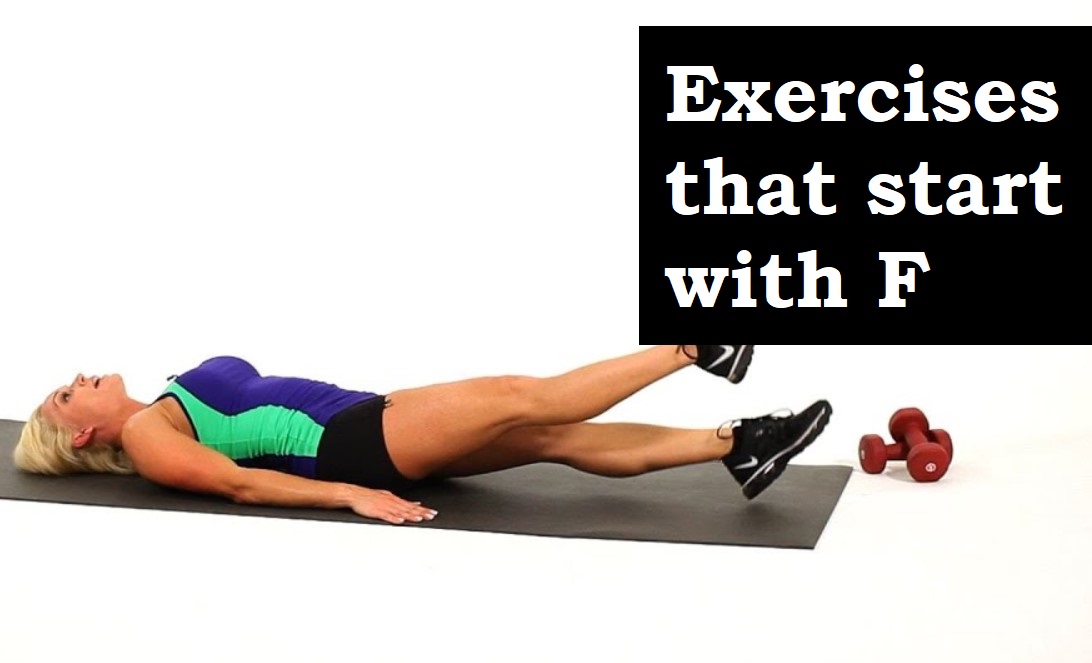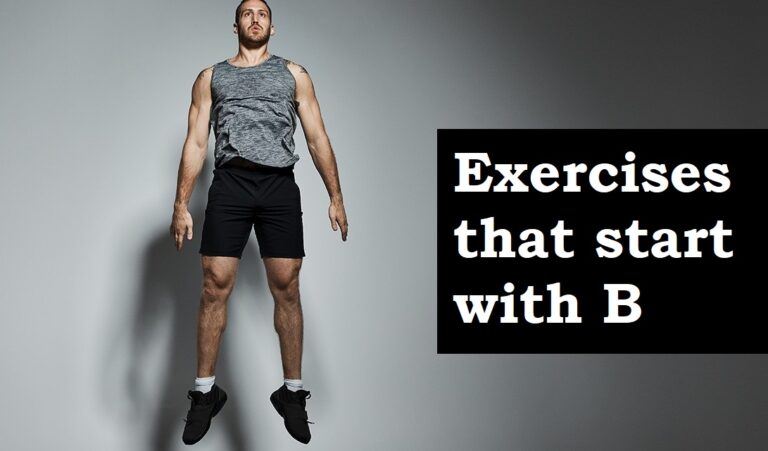10 Exercises that start with F (How to, Muscles Worked, Calorie Burn)
Embarking on a fitness journey is a commendable step towards better health and overall well-being. Including a diverse range of exercises in your workout routine can help you target different muscle groups, enhance your strength, flexibility, and cardiovascular fitness. If you’re on the lookout for effective exercises that start with the letter “F,” you’re in for a treat!
Read the proper techniques for each exercise, evaluate their intensity levels, analyze the muscles they work, and estimate the average calorie burn associated with each activity.
Flutter Kicks
How To: Flutter kicks are a dynamic abdominal exercise that engages the lower abdominal muscles. Lie on your back with your arms at your sides and legs extended.
Lift your heels slightly off the ground and perform small, quick kicks with your legs, alternating between raising one leg higher than the other.
Intensity Level: Beginners can start with a set of 20 to 30 seconds of flutter kicks and gradually increase the duration as they build core strength.
Muscles Worked: Flutter kicks primarily target the lower abs, hip flexors, and quadriceps.
Average Calorie Burn: A 15-minute session of flutter kicks can burn approximately 50 to 70 calories.
Front Squats
How To: Front squats are an excellent compound exercise that primarily targets the lower body muscles. Begin by placing a barbell across the front of your shoulders, resting on your collarbone. Stand with your feet shoulder-width apart.
Lower your body by bending your knees and pushing your hips back. Keep your chest up and core engaged. Descend until your thighs are parallel to the ground or slightly below, and then push back up to the starting position.
Intensity Level: Front squats require some lower body strength and flexibility. Beginners can start with bodyweight squats and gradually progress to using a barbell.
Muscles Worked: Front squats primarily target the quadriceps, hamstrings, glutes, and core.
Average Calorie Burn: A 30-minute session of front squats can burn approximately 200 to 300 calories.
Frog Jumps
How To: Frog jumps, also known as squat jumps, are a plyometric exercise that improves lower body power and cardiovascular fitness. Start in a squat position with your feet shoulder-width apart.
Lower your body into a deep squat, then explosively jump as high as you can, swinging your arms overhead. Land softly in a squat position and immediately go into the next jump.
Intensity Level: Frog jumps are high-intensity exercises that should be performed with caution. Beginners can start with a few repetitions and gradually increase as they become more comfortable.
Muscles Worked: Frog jumps primarily target the quadriceps, hamstrings, glutes, and calves.
Average Calorie Burn: A 15-minute session of frog jumps can burn approximately 100 to 150 calories.
Forearm Plank
How To: The forearm plank is a classic core exercise that builds stability and strength in the abdominal muscles. Begin on your elbows and toes, forming a straight line from head to heels.
Engage your core and hold the position for as long as you can maintain proper form.
Intensity Level: The intensity of the forearm plank can be adjusted by varying the duration of the hold. Beginners may start with shorter holds and gradually work up to longer durations.
Muscles Worked: The forearm plank primarily targets the rectus abdominis, transverse abdominis, and obliques. It also engages the muscles of the shoulders and back.
Average Calorie Burn: The forearm plank is a static exercise and may not contribute significantly to calorie burn. However, it is essential for building core strength.
Fencing Lunges
How To: Fencing lunges are a fun and effective way to work on balance, coordination, and leg strength. Start with your feet together and take a step forward with one foot, lowering your body into a lunge position.
Your front knee should be bent at a 90-degree angle, and your back knee should hover just above the ground. Push off with your front foot and return to the starting position. Repeat on the other side.
Intensity Level: Fencing lunges can be adjusted by controlling the depth of the lunge and the speed of the movement. Beginners can start with smaller lunges and gradually progress to a deeper lunge.
Muscles Worked: Fencing lunges primarily target the quadriceps, hamstrings, glutes, and calves.
Average Calorie Burn: A 15-minute session of fencing lunges can burn approximately 100 to 150 calories.
Floor Wipers
How To: Floor wipers are an advanced core exercise that also engages the upper body. Lie on your back with your arms extended to the sides.
Lift your legs off the ground and rotate them to one side, aiming to touch the floor with your toes. Bring your legs back to the center and repeat on the other side.
Intensity Level: Floor wipers require significant core strength and control. Beginners can start with a smaller range of motion and gradually increase as they progress.
Muscles Worked: Floor wipers target the rectus abdominis, obliques, hip flexors, and adductors.
Average Calorie Burn: A 15-minute session of floor wipers can burn approximately 70 to 100 calories.
Full-Body Burpees
How To: Full-body burpees are an intense total-body exercise that combines a squat, plank, push-up, and jump. Begin in a standing position.
Drop into a squat position and place your hands on the ground. Kick your feet back into a plank position and perform a push-up.
Jump your feet back to the squat position and explosively jump up, reaching your arms overhead.
Intensity Level: Full-body burpees are high-intensity exercises that require coordination and stamina. Beginners can start with modified burpees by skipping the push-up or the jump.
Muscles Worked: Full-body burpees target the quadriceps, hamstrings, glutes, chest, shoulders, and triceps.
Average Calorie Burn: A 15-minute session of full-body burpees can burn approximately 150 to 200 calories.
Frog Pump
How To: The frog pump is a variation of the glute bridge exercise that targets the glutes and hamstrings. Lie on your back with your knees bent and feet together, flat on the floor. Place your arms at your sides with your palms facing down.
Push through your heels and lift your hips off the ground, squeezing your glutes at the top. Lower your hips back down, allowing your knees to fall open like a frog.
Intensity Level: Beginners can start with bodyweight frog pumps and progress to adding resistance, such as a barbell or dumbbell, as they become more comfortable.
Muscles Worked: The frog pump primarily targets the glutes, hamstrings, and lower back.
Average Calorie Burn: A 15-minute session of frog pumps can burn approximately 50 to 70 calories.
Fire Hydrants
How To: Fire hydrants are a great exercise for targeting the glutes and hips. Start on all fours with your hands under your shoulders and knees under your hips. Keeping your knee bent, lift one leg out to the side, creating a 90-degree angle at the hip. Lower the leg back down to the starting position and repeat on the other side.
Intensity Level: Fire hydrants can be adjusted by controlling the range of motion and tempo. Beginners can start with a few repetitions and gradually increase the number as they build glute strength.
Muscles Worked: Fire hydrants primarily target the gluteus medius and minimus muscles.
Average Calorie Burn: A 15-minute session of fire hydrants can burn approximately 50 to 70 calories.
Forearm Stand (Pincha Mayurasana)
How To: The forearm stand is an advanced yoga pose that requires upper body strength and balance. Begin in a dolphin pose by resting on your forearms and walking your feet toward your elbows. Engage your core and lift your feet off the ground, bringing your body into a vertical position.
Intensity Level: The forearm stand is a challenging pose that requires practice and patience. Beginners can start with forearm plank variations and work on building shoulder and core strength before attempting the full pose.
Muscles Worked: The forearm stand primarily targets the shoulders, core, and upper back.
Average Calorie Burn: The forearm stand is a static yoga pose and may not contribute significantly to calorie burn. However, it offers other valuable benefits, such as improved balance and upper body strength.
Conclusion
Incorporating a diverse set of exercises that start with the letter “F” into your fitness routine can elevate your workouts and help you achieve your health and fitness goals.
From full-body compound movements like front squats and burpees to targeted exercises like flutter kicks and fire hydrants, these ten workouts offer a well-rounded approach to improving strength, flexibility, and cardiovascular fitness.
Remember to warm up before each session and focus on maintaining proper form during each exercise to prevent injuries. Whether you’re a beginner or an experienced fitness enthusiast, these exercises will invigorate your routine and contribute to a healthier, fitter you. Stay committed, and the results will follow. Happy exercising!







